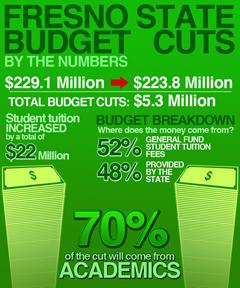Following the trend of the last few years, Fresno State is implementing yet another budget cut for the 2011-12 fiscal year, with students and teachers seeing the largest effects.
According to associate vice president of financial affairs Clint Moffitt, Fresno State’s budget is being cut by just less than $6 million for the fiscal year.
Moffit said the state’s general fund is $223.8 million. Last year Fresno State spent $229.1 million.
“The state has allocated less money to CSUs and UCs,” Moffitt said. “All of the schools have taken their respective amount of reduction.”
Alongside this, student tuition has increased as well to make up for the cuts. To make up for losses in the budget, student tuition has increased by a total of $22 million.
“[About] 52 percent of our budget comes from our general fund, student tuition and fees,” Moffitt said. “The state is only providing 48 percent.”
Staff salaries and staff benefits make up 80 percent of the school’s budget, Moffitt said. After that, maintenance and utility charges are the highest percentage of spending.
Those most likely to see an effect from the budget cuts are students and teachers.
“Academics is going to take 70 percent of the cut,” Moffitt said.
Provost William A. Covino said that students will not see large changes over the next year, rather that the budget has been affecting us slowly. As provost, Covino is a part of the committee that manages the academic budget.
“The largest portion of the university budget is the academic budget,” Covino said. “The budget reduction affects us in academic affairs in a big way, because it impacts the library, all of the school and colleges, all of the academic departments, our research programs, our centers and institutions, etc.”
An academic affair budget reduction task force has been set up to maintain the quality of education at Fresno State. Covino explained that the budget was being cut when he arrived at the university in 2009.
To make up for the cuts in the budget this year, academic affairs has cut administrative positions, reduced staff positions, reduced funding to academic-funded programs and the schools and colleges are all running on reduced budgets.
“The schools and colleges are trying to decrease the cost of low enrollment, low demand courses,” Covino said. “They are putting their dollars into high-enrollment, high-demand courses.”
What this means for students is less variety in terms of class selection.
“Students are going to need to plan more carefully and will be faced with few options for courses that they need,” Covino said.
Covino said that we won’t see any shifts toward online classes or a reduction of Friday classes because of the budget cuts. There are also no furlough days planned for the coming semesters.
“Online courses don’t necessarily save money,” Covino said.
Professors will also see effects from the cuts, dean of undergraduate studies Dennis Nef explained.
“We can see some of that this fall when you look at the average class size,” Nef said. “The average class size has gone up a little bit in most programs.”
Departments are having to offer larger sections so they can fund smaller major courses that they still need, Nef said.
“We have a lot of small-section courses,” Nef said. “If we teach them less frequently, instead of once every semester, we teach them once every other semester and we advise students.”
Students “are still going to get the same level of education, we are just able to deliver it at a lower cost,” Nef added.
In total, teachers have seen about a 10-percent increase in class size.
But this doesn’t take into account that some courses are larger, while some classes remain the same, said Lisa Weston, chair of the California Faculty Association and the English department at Fresno State.
“Obviously, we are not happy about this,” Weston said. “What this means is less time for students. It effectively increases our workload. We are getting paid the same amount of money to do more work.”
Weston said she has been noticing much fuller general education courses.
One of the other problems that Weston has seen is an increase in the “invisible work” that professors do without credit or pay.
“We haven’t been replacing retired faculty,” Weston said. “And what that means is we have more work to do because there [are] fewer people to sit on the same committees and task forces.”
Weston also noted that more and more of her colleagues are taking more sick days.
“We’d like to see a rational workload that will allow us to teach the students as we think best, rather than what’s efficient,” Weston said. “In terms of the budget, during tough times, it would be a good idea to see more money go into the classrooms, rather than new creative and wonderful initiatives.”
Moffitt says that students may also see longer lines in campus offices.
“Students are going to find that some services have decreased,” Moffitt said. “There will be longer lines in some areas because administrators have reduced their staff.”
One thing students won’t see though is a decrease in library hours. Because of continued complaints regarding the library hours, funds have been allotted to maintain those as well as the tutoring center, Moffitt and Covino explained.
Moffitt said that it is likely students will again see tuition increases in the coming years.
“If the state appropriation is reduced again, we will most likely see some tuition increases,” Moffitt said.
Moffitt explained that one of the only ways to fix the long-standing problems that Fresno State has with the budget is for students to talk to their representatives.
“Students need to get into contact with their local legislatures and state representatives,” Moffitt said. “We need to reinforce the concept that the CSU system provides higher education to students. The trend needs to be to stop providing less and less.”





